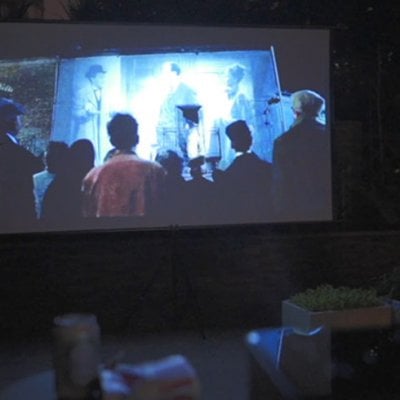Projector screens are bigger than ever. From home theaters to classrooms, projectors have a lot of perks. While choosing the right projector is already a big task, the screen is essential. With so many material options, how can you pick?

Whether you’re interested in a DIY screen or curious about what the market has to offer, we’re listing the top six projector screen materials.
Top 6 Projector Screen Materials
For the best visual capabilities and budget considerations, here are the top six materials for projector screens.
1. Paint
Paint is simple but effective. You’ll need wall space or a canvas with enough space to serve as a screen. The wall option guarantees the flattest surface possible, which can improve your viewing experience.
Whether you’re DIY-ing or using the store-bought option, a canvas can be stretched tight over the frame, creating a flatter surface. However, it won’t have the tautness of a wall. Still, a well-made canvas might even fool the perfectionist in your viewing group.
Any paint will do. You might choose classic matte white for the most versatile viewing experience. Still, other colors can be equally effective depending on the ambient light in your screen room. However, if your budget is higher, you can also try screen or projector paint. If your wall is already blank, you have a screen at no extra cost.

Pros
- Budget-friendly
- Doesn’t take up space
- Easily adjustable screen size
- Higher-resolution potential
Cons
- You need wall space
- Requires time to paint/dry
2. Bedsheet Fabric
It might not be high-tech, but a bed sheet is an easy screen solution. However, you should pick a fresh bed sheet rather than stained or torn fabric. It’s also wise to run an iron over the sheet to remove any stubborn wrinkles.
Cotton and polyester blends are preferable for stretchability and image quality. You’ll also need something to secure your sheet. For example, you might use tacks or nails to fasten the sheet directly to the wall. Optionally, you can place the sheet over a frame, such as flat cardboard or a larger picture frame. Adding extra layers can help prevent light from shining through the sheet, which improves visual quality.
Pros
- Budget-friendly
- Easily moveable
- Screen size can be easily trimmed/shaped
Cons
- Material might be too thin and translucent
- Folds/wrinkles may be distracting
3. Blackout Cloth
Blackout cloth, like blackout curtains, is opaque and non-reflective. It prevents other incidental light sources from washing out your screen and ensures that the optimal amount of lights from your projector is viewable.
If you’re thinking about tucking your screen material away when not needed, blackout cloth is somewhat flexible and lightweight. It also has color options, as it’s a material available in various colors. However, white, black, or grey are the top choices for screens.
Pros
- Opaqueness aids visual quality
- Easily rolled away
- Readily available
Cons
- Textured fabric surface impacts image smoothness
- Requires a frame or hanging apparatus suitable for heavier fabric
4. Plastic
Plastic is one of the most common materials for projector screens. Depending on how much you need, the cost is likely within your budget, even for larger screen sizes. However, be careful of the plastic sheen, as too much shine will bounce back too much light and wash out your projection.

A white plastic surface with limited gloss will produce the best results. However, if you find a non-white plastic slab in the correct size, remember that the shade won’t impact image quality. Instead, it will affect the shades of your visuals.
Pros
- Lightweight
- Budget-friendly
- Various size options, pre-made or DIY
Cons
- Glossy material can dull colors and wash out imagery
- Wide variety of quality can make it difficult to choose
5. PVC Fabric
PVC is a polymer material frequently used by commercial projector screens. The material is soft but durable, which makes it pliable for shaping into taut screens. In addition, PVC fabric creates accurate color with high-resolution image quality.
The material is used for sports clothing, commercial tents, and fire protective clothing because it’s resistant to fire and moisture. In addition, you can use PVC fabric for indoor or outdoor projector screens.
Pros
- Durable
- Anti-UV
- Defined colors
- High-resolution potential
Cons
- Pricier than other materials
- Less DIY-friendly than other materials

6. Fiberglass
Fiberglass isn’t just for window screens. It’s an upgrade from a plastic screen, as the material is more durable. It’s also more flexible, which can help create a taut screen surface for better projection.
As a bonus, fiberglass mesh is flexible but doesn’t crease, making it simpler to shape it. Size shouldn’t be an issue as rolls are available in various lengths and widths. However, opt for the mesh weave with denser, tinier holes for the best picture quality.
Pros
- Durable
- Reduces reflection of ambient light
- Uniform light diffusion
Cons
- Pricier than other materials
- Should be cleaned regularly (dust, fingerprints, etc.)

Other Screen Considerations
Material is a significant consideration, but there are other things you should know to achieve the best screen results.
Projector Type and Ratio
Before you can assess the best screen material, you should know your projector type. For the best results, familiarize yourself with your projector type and capabilities. It’s possible to have the best projector screen material but still view grainy or blurry visuals. Understand what your projector needs for an optimal setup for the best visuals.

Screen Color
While material should be the primary factor, the color of the material is another impactful decision. Whether off-white, yellowish, or another shade, the background will influence how the on-screen colors appear.
Projectors will work on any color. But, before settling for the first color you find, consider what you’ll be viewing and the space where you’ll be watching.
For example, a white screen is the best choice in a completely blacked-out room with a weaker or dimmer projector. On the other hand, picture a space where light peaks through, such as ambient lighting or light-reflecting decor. In that situation, a black screen offers the best contrast, producing better-defined colors.
Conclusion
Projector enthusiasts have tried plenty of different screen materials, but we’re confident about the top six. We hope you’ll try one soon and start enjoying your screen time.
Are you ready to set up your screening space? Which of the top six will showcase your projector?




